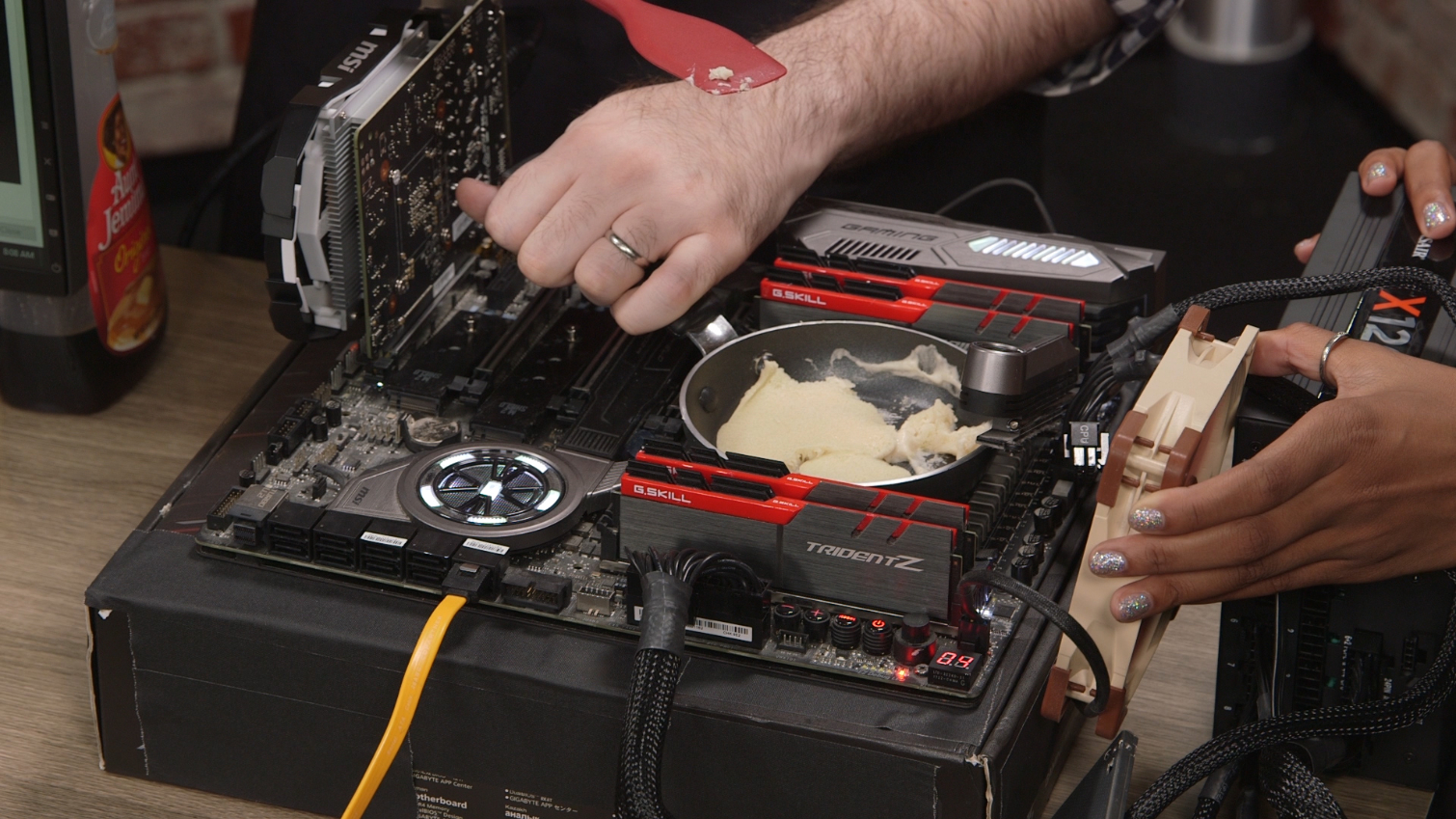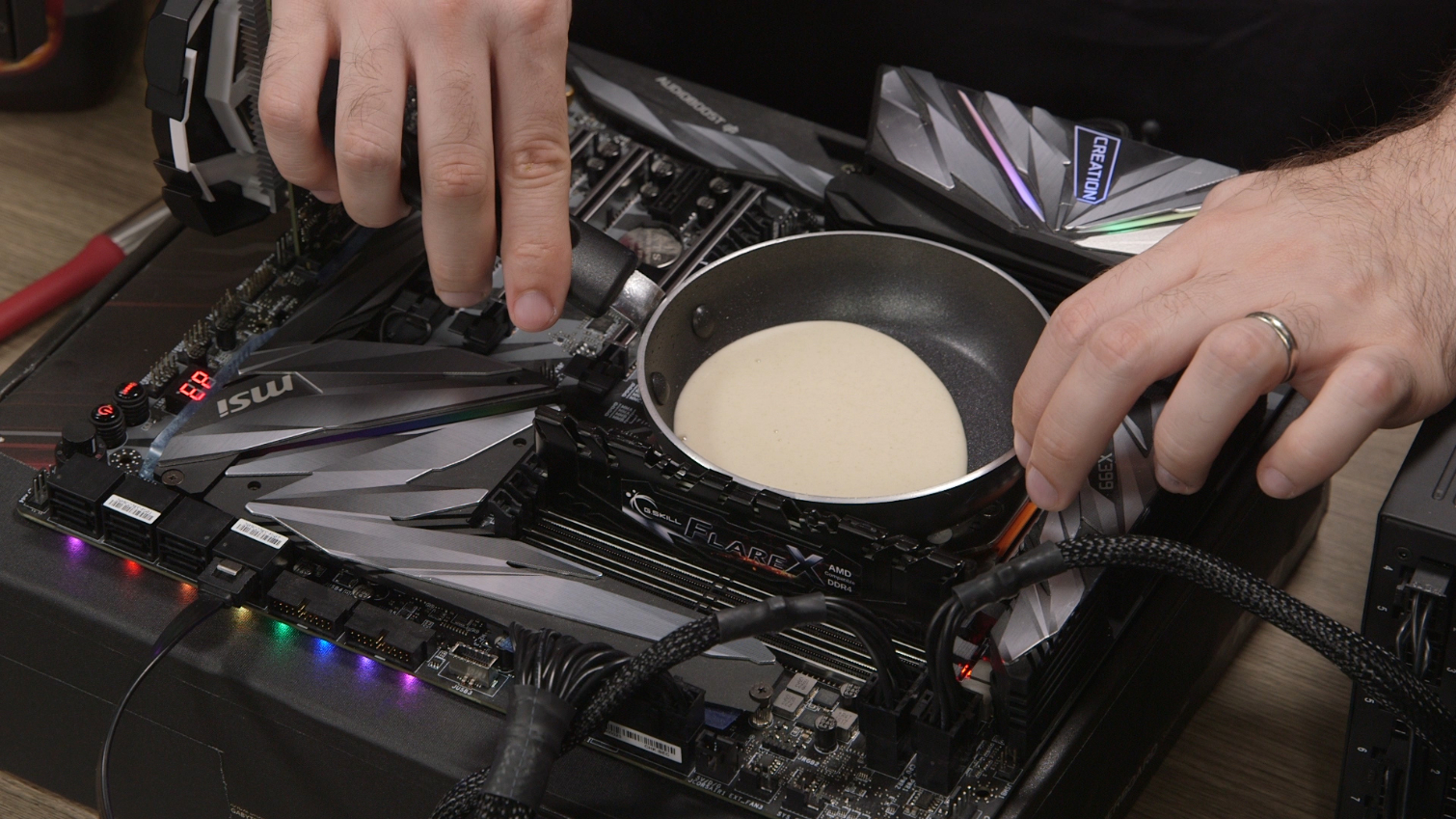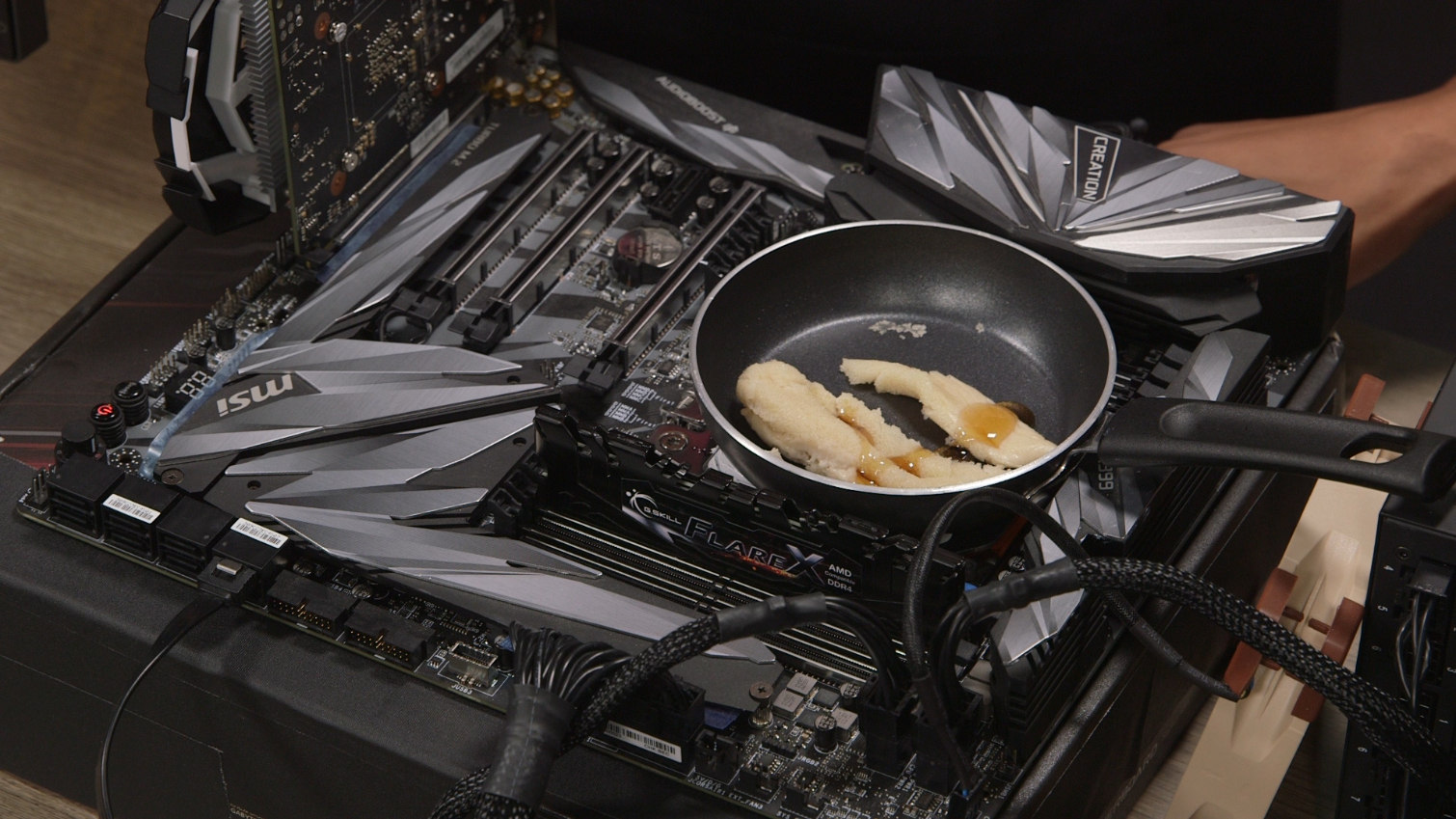AMD vs Intel: Which CPU Cooks Better Pancakes?
There are lots of great cooking competitions. There’s Chopped, Hell’s Kitchen, MasterChef Junior. But in the Tom’s Hardware labs test kitchen, we don’t pit chefs against each other. We pit processors against each other. So we took Intel and AMD’s HEDT processors to find out, which of the two company’s high-end chips makes a better pancake?
The chips we used were the Intel Core i9-9980XE and the AMD Threadripper 2990WX, with the former on a MSI X299 XPower Gaming AC board and the latter running on an MSI MEG X 399 Creation board. Both used identical GPUs (an Nvidia GeForce GTX 1050 used solely for video out) and power supplies.
| CPU | Motherboard |
| Intel Core i9-9980XE | MSI X299 XPower Gaming AC |
| AMD Threadripper 2990WX | MSI MEG X 399 Creation |
The thing is, you can’t fit a terribly large pan on a motherboard. We got the smallest one we could find, at 4.25 inches, which would double as a heat sink. To better enable heat transfer to the pan, we smothered the processors in Cooler Master Ice Fusion thermal grease. It’s far more grease than we would normally use, but there were grooves in the bottom of the pan, and we wanted to fill those as much as we could. Besides, we weren’t actually using this for performance or cooling, just for cooking.
Ideally, we would have drilled holes in the pan and screwed them into the motherboards to turn it into a sort of mount. But we had to make this one pan work on two different motherboards with differently shaped processors, so we had to put as much equal pressure on the pan as possible.
Before we start regaling you with stories of breakfasts made over silicon, here’s your notice: don’t try this at home. You might ruin your CPU, motherboard or other components. Alternatively, you could burn yourself while applying pressure to the pan.
While much of the fun has been written up below, be sure to watch the video to see hijinks ensue.
Making Pancakes on an Intel Core i9-9980XE
Cooking on the Core i9-9980XE produced a unique challenge, because despite the fact that the pan was really small, it didn’t fit quite right on the MSI X299 XPower Gaming AC. To get it on, we had to remove two screws from the back of the board and lift off the VRM cooler. That was attached to a heat pipe, so we had to be cautious in bending it back.
Get Tom's Hardware's best news and in-depth reviews, straight to your inbox.
In the BIOS, we increased the thermal throttle limit from 100 degrees Celsius to 105 degrees Celsius. After all, we didn’t need the computer to run well, just run hot enough to cook some batter.
Then, we applied a bunch of thermal paste and prepared to cook. It fit into the grooves on the pan. Once that happened, we rubbed down the top of the pan with a little olive oil to reduce sticking.
And the Intel processor hit about 74 degrees Celsius at idle and easily hit 104 degrees Celsius when we tossed in an AIDA64 stress test.
At one point, the system shut down, so we pulled out a Noctua NF-S12A case fan and pointed it at the VRMs, which cooled down enough to get things running again.
Slowly but surely, the batter began to bubble. When we decided to flip it, it was baked, but we probably should have left it on longer for a perfect golden brown.
It ultimately took us to just under 16 minutes to get the pancake solid, albeit a bit broken and not necessarily beautiful. It tasted just fine, though.
Making Pancakes on an AMD Threadripper 2990WX
There were high hopes for pancakes on Threadripper 2990WX because the CPU is physically larger than the Intel Core i9-9980XE. That not only gave us a bigger stovetop, but the larger surface should make it easier to transfer heat.
In the interest of fairness, we attempted to change the throttle threshold to 105 degrees Celsius, but couldn’t. In this case, we didn’t need to remove VRM coolers from the MEG X399 Creation.
So we applied an aggressive amount of TIM to get in the grooves of the pan and got to work.
The pan (and the batter in it) was easily a more effective cooler on the Threadripper. At idle, it was only running between 40 and 50 degrees Celsius. So we ran the AIDA64 stress test to heat it up.
The pancakes started to bubble in a more even fashion than they did on the 9980XE, and we got excited. That was, until the system shut off. Each time we turned it back on, there would be another error code, or it would shut down before it could get back to the desktop.
The VRM coolers were hot to the touch, so we grabbed the Noctua NF-S12A fan again to cool them down. But that didn’t cool anything down enough to get the computer to start up again.
As we approached the amount of time it took the 9980XE to make a pancake, we decided to flip the one on the Threadripper. Because while the system wasn’t on, the chip was still hot, as was the pan. Think of it like when you turn the heat off under a pan on your stove; some cooking can still occur.
But the amount of time on the pan, which was slowly starting to cool, only barely solidified it. We had to scrape it off carefully to keep it from breaking unlike the Intel pancake. And after a bit of time on both sides with no way to get the computer going, we gave up at around 18 minutes.
There’s a number of reasons this could have happened. One would assume that the processor would throttle under intense heat rather than shut down, but it shut down instead. While it could be the processor’s fault, the shutdown could easily have been due to the motherboard’s BIOS. We reached out to AMD for more information, but didn’t receive a response prior to publication.
For the sake of completion and fairness, we tried the pancake. No, it wasn’t fully cooked. No, you shouldn’t do that at home. It tasted like a pancake alright, but it was liquidy. The texture was just gross.
If You Can’t Stand the Heat…
It’s clear that there are cheaper and easier ways to cook pancakes. And in more realistic use cases such as gaming or content creation, the Intel Core i9-9980XE and AMD Threadripper 2990WX each have their own strengths. When we did a formal face-off between the two chips, they came up tied. But, when it comes to cooking, there is one clear winner.
It took far less time to make a better pancake on the Core i9-9980XE, because the system only shut down once and, after we increased the throttle limit, it was hot enough to put out a pancake in 15 minutes. While that’s long for a pancake, I imagine we could have even have gotten it a nice golden brown if we were more patient. It took over 18 minutes to get something goopy on the Threadripper.
In short: if you want to use your HEDT chip to make pancakes, go Intel. If you want to know how we these chips perform at computing tasks, read our reviews.

Andrew E. Freedman is a senior editor at Tom's Hardware focusing on laptops, desktops and gaming. He also keeps up with the latest news. A lover of all things gaming and tech, his previous work has shown up in Tom's Guide, Laptop Mag, Kotaku, PCMag and Complex, among others. Follow him on Threads @FreedmanAE and BlueSky @andrewfreedman.net. You can send him tips on Signal: andrewfreedman.01
-
Roland Of Gilead Haha :tearsofjoy: Pure brilliance. Love that article, specially this: 'We reached out to AMD for more information, but didn’t receive a response prior to publication. 'Reply
Hey AMD, we've been making pancakes on your TR CPU, and it crashed and we couldn't get it running again. Can you offer any advise! :tearsofjoy: -
TJ Hooker How long until redgarl shows up accusing the article of being biased against AMD? Clearly AMD would have won if Tomshardware weren't a bunch of Intel shills :pReply -
joeblowsmynose I think a cast Iron pan would have been much better. First you don't have those grooves blocking efficient heat transfer - the smooth bottom on the cast iron pan would require far less grease and transfer the heat better. Also it would be able to absorb much more overall heat, rendering a much better cooking experience, and you can get those in "tiny" format as well. Cast Iron just makes everything taste better anyway.Reply
So I want to see a rematch with a better pan after you find a way to keep the TR system running. :)
This is one of the best articles I've seen at Tom's in a while. :) Great fun. -
Lutfij Maybe see if you can slow cook a hearty soup atop that setup using a cast iron pot, with a lapped underside so it has smooth contact patch to make with the IHS of the processors(s).Reply
In that write up, you can have the same conclusion :D -
InvalidError Both CPUs may be able to make better pancakes if there was a solid aluminum block CPU-to-pan adapter between the IHS and pan - quickly and evenly pull heat out of the CPU so the CPU does not have as severe hot-spotting as it would with manual pan pressure and spread it more evenly under the pan so pan contact wouldn't be as critical. Machine the TR4 and LGA adapters to the same weight so they both require the same amount of specific heat to warm up. The adapter would also solve the problem with chipset heatsink and other board feature clearances.Reply -
RainingTacco Quality stuff. If i ever find myself in postapocalyptic scenario where i wont have any high resistance wire laying around, but i had a plenty of motherboards, cpus and batteries/power source and raw pancake dough, while being erroneously hungry, then after this test i can finally sleep well knowing that intel chips are better in making pancakes.Reply




